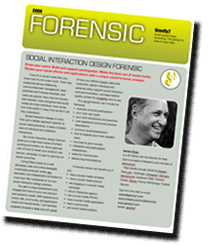My Dad used to tell a joke that would send him into eye-tearing peals of self-induced laughter. He's a group therapist, and trained with Transactional Analysts. TA is the school of thought that gave us "I'm OK, You're OK." And the idea that the real function of talk is the transaction of emotional "strokes." Moments of acknowledgment, recognition, and validation.
"Two Transactional Analysts run into each other in the hall," he'd say, (already visibly giggly...) "One says to the other" (now audibly giggling...) "You're OK! How am I?" (...things fall apart.)
And I had no freaking idea why it was funny, but of course I laughed my butt off, as did my little sister, and for a brief moment the little family that couldn't was whole. That little ritual was our economy of "fine," a transaction guaranteed to work because giggle fits are contagious no matter what the joke is about. And in our infrequent visits with Dad, comedy was the fastest-acting glue we had.
Of course the whole situation was a microcosmic example of TA at work. In our family, "You're OK. How am I?" was a lot more common than I'm OK, How are you? and certainly more common than "I'm OK. You're OK." Which soldered the wiring by means of which I now find myself inescapably drawn to observing and thinking about Other people.
I wrote last week that I thought we social media folks needed to think more about what other people do with our tools (twitter). That there seemed plenty of How To's about tweeting, but little about reading tweets. Lots about success, branding, visibility, status, and so on... but little about having a good experience.
As a user experience guy I can't afford to allow my own personal experience to determine what I think the overall user experience is. But nor can I assume nor should I presume to know what others experience, either. Conundrum. For social media are not products or tools, to me, but social practices, cultures, habits, and personal styles that make use of tools. Making use: not getting utility from, not using for, not using in order to, and not "use cases." Truly using: developing habits and routines, for socializing, soliciting business, chatting, meeting and friending, and so on.
I like to emphasize user experience and social practices not only because I think that social media succeed or fail based on the user experiences they can facilitate. But also because I think the user experience deserves investigation. In my opinion, we too commonly extend real-world situations and practices to the online "world." And we too often lean on metaphors and ideas that may describe, but rarely explain, what it's all about.
For example, we say that social media connect. That they are transparent, democratizing, connecting, social. That they are about friends, communicating, and conversation. Yes, when compared to conventional software, or when compared to broadcast media. They are more connected, conversational, transparent, flattening, and social than those forms of media. But if we try to describe social media as things, our western cultural thing with things gets in the way of our grasping dynamics and processes, habits and routines, expressions and feelings. Verbs. When social media are things used, emphasis should be on the using, not the thing. It is we, not the tool, that make use (and make things useful).
Social media are socially different and differently social. As they are socially differentiating and differently socializing. And open social tools like twitter are so multi-faceted and multi-purpose that there would be little hope of our capturing what they "are" or how they "work" if we didn't know what people do with them.
And therein lies some of the rub. Each of us can only know our own experience. Those of us who forsake observation and study can only hope to connect with people who either believe us, or agree with us. Enthusiasm for social media (because it's new or better or good), evangelism of social media (ditto) only pitch sales. Necessary for the industry, but not sufficient for a design or implementation practice. Critical thinking, observation, self-awareness, and reflection are needed if we are to do more than talk about social media and instead understand how it works, in what cases, and for whom.
The two aspects of social media that we need to grasp, formally if we can, are the social system and its individual user experiences. There are system-level processes, as there are with any social system (an economy, a legal system, an educational system). And there are participants (workers, defendants, students and teachers). The system organizes, has structure, and is reproduced over time by the acts and activities of its participants (who are unaware that their contributions keep everything running, and who don't have the system in mind they they "use" it).
We might use functional descriptions to describe the operations of the system: its elements, processes, and outcomes. And there are intentions, motives, thoughts, habits, plans, ambitions and so on of the participants. Social media are social, but in a highly-structured way. Most of what you or I can do on social media is very limited indeed (excepting talk, which has infinitely possibilities of creating meaning). And what you or I do will seem the same, insofar as what we think we're doing is not captured.
Social media offer extremely limited ways of selecting and acting on information (and objects, statements, links, videos, etc). We can add, connect, qualify, and attribute. Add to a list, collection, or set. Connect information, pages, items, people. Qualify by means of a normalized choice between up/down, yes/no, or quantitative rating system.
There is no fuzzy here. No "sort of," "maybe," or "somewhat" unless by means of the words "sort of" "maybe" "somewhat." Ambiguity of choice is excluded, selections are determining, and all selections look the same once made.
User experience folks know action systems. interaction systems, too, insofar as users interact with software applications. But human social interactions comprise of meaning, and are fundamentally un-resolvable. Meaning escapes codification and stability always and in all cases: it is a negotiation, and can involve either an attempt to reach understanding between people, or effects in the world (including effects on people).
Conventional user experience approaches cover the action of the user, but not the interactions among users. We have no language or framework for the other side, for the response or uptake of a user's action when that action is communication with another user. We're unable to describe social interactions on social media because we cannot accommodate human interactions (with each other). If users use twitter in order to interact with each other, not with twitter itself, then we need some kind of framework that covers not only the acting user but the responding user. The successes as well as the failures -- which I suspect may constitute the vast majority of mediated social interactions.
It's important that we understand that social media are communication systems. That's the "type" of social system they are. They only work if the communicating action of one user is taken up in some way by another user. Now the system can capture the actions of a user and then represent them on screen (these are the "views" of social action we design: lists, boxes, ratings, all that). But it's the uptake of an action that continues the process of communication and connects users with one another. Social media would fail if no users took up each others' contributions and acted on them, spoke about them, responded directly to them, shared them, and so on.
So the design approach needs to accommodate both sides: what is a user doing, and how might another user respond? We're good at the first part, but poor at the second part. We have a one-sided approach to user actions. We don't have a grasp of responses.
I'm a responsive person. That is, my communication style is strongly informed by who I'm talking to. And I can adapt what I say, how, and in what manner and style based on the situation at hand, and who's present. Twitter is hard for me because I don't get enough material from it -- so I read through the wire and try to guage what's meant and intended. Tweeting what I'm doing isn't in my idiom.
They say that we view ourselves as complicated, complex, and changing, but that we view others as whole. I try not to do this. I try to perceive, if not understand, differences. Identities to me are objects. People are differences, and are differentiating. I think that if we knew what kinds of people resonate well together, we might be able to anticipate how a new social media product will succeed. Who will use it, find community on it, relate to others through it. Wikipedians, social bookmarkers, youtubers, facebookers, diggers, lastfmers, yelpers, twitterers: these are all possibly different kinds of people. I like to converse, I never delicious. I like to read status updates, but I often feel silly posting my own.
But the tools don't define the user type. Nor for that matter do market segments. There aren't "creators." What's a creator? A creative person? A person who upload and adds stuff? A blogger? Is a commentator not a creator? People don't break down into types of people who adopt in stages, or who add but don't consume, consume but don't participate, and so on. No, people are doing something, know what they're doing, are interested in what they're doing, and care about what happens afterwards. We get as far as describing what users do, how they "behave" or act, and then stop before trying to understand what happens next. Which is precisely that which makes a social media service a dynamic system of communication: actions taken up in a temporally open, un-bounded, discontinuous, and separated "flow" of activity.
In trying to grasp the user experience, I've tried to learn from others what they think social media is. I have reflected on the many stages of experience I've personally had in social media -- which goes back more than 10 years. I've tried to make sense, with the purpose of formalizing a framework for social interaction design, of different user interests, personalities, styles of use, and so on. Recently, of course, most of our attention has been on twitter. And recently, in particular, I've had some interesting conversations about the state of social media, and about interactions with and around twitter in particular.
I've noticed that people have very different ways of using twitter. Social media experts make many different claims about twitter. Many of these seem to project the person's personal use, and professional experience. Surprisingly, these often disagree or even contradict each other.
Among twitterers, for example, friends and colleagues have described it, and their use of it, as:
- a stage
- a scene
- a conversation
- their reputation
- an extension of their blog
- a way to stay in touch
- a way to meet new people
- a way to let people know what they're up to
- a way to document the day
- marketing
- a way to be seen
This would tell us that some people use twitter for personal reasons, some for social reasons, and some to be seen by the public. The differences among the ways people describe twitter include descriptions of what twitter is (to them), what they're using it for, what purposes it serves, and so on. In how we describe twitter, we reveal something of how we relate to it and to what we do with it.
If these are some ways of relating to twitter, then, similarly, there are different ways of "behaving" on twitter:
- A person who uses twitter to extend his online reputation may attend mostly to himself. He might want to count and track retweets. To grow an audience. To protect his reputation. And maybe, not spend much time with people who aren't in his audience.
- A person who uses twitter to broadcast might seem to have an impersonal style of behavior. She might use it to post updates, circulate news and announcements. Extend her blog. If she's not interested in getting "caught up" in conversations, she may tend to follow back less, @reply less, and pay less attention to what others are doing.
- A person who uses twitter to be a part of a social scene may tend to use it to coordinate social activities. Twitter might primarily be a source then of social news and updates -- from friends and colleagues. The person might use twitter to stay connected and looped into social engagements. His interest, if he has one, in tracking twitter traffic may be insofar as he feels he is getting attention and being noticed, rather than, say, an indication of his reputation as an expert.
And there are many more distinctions we might make among different ways of relating to and using twitter. They would correspond to the ways in which we participate in the "attention economy":
- Giving attention
- Getting attention
- Paying attention
- Soaking up attention
- Attracting attention
- Sharing attention
- Competing for attention
- Mediating attention
- Measuring attention
- Manipulating attention
- Returning attention
How people make themselves visible and relevant on twitter would differ, then, too. Differences in our social skills and competencies come to bear on how we tweet. There are differences in:
- What we say
- Who we say it to
- Who we reply to
- Who we follow and why
- Who we follow back, or not, and why
- Who we RT and why
- What we RT and why
These differences are explained by how we think twitter "works":
- If it is a public medium, then we may pay attention to those who are getting attention.
- If it is our friends and social scene, we may not pay attention to people outside of that
- If our friendships are close and loyal, we may pay good attention to what our friends are saying
- And if we hope to be noticed by those we respect, we may offer our attention and hope that it comes back to us
- If we have a reputation to caretake, we may not want to encourage people who seem not to recognize or know it
- If we have a certain social status, we may think about who we spend it on
Social dynamics are at play in all of these examples, even for those people whose tweeting is only thinly social. These dynamics involve what people do with twitter and why and how, but not simply in terms of their actions. In most of these cases, interaction is solicited, appealed to, hoped for, expected, monitored, measured, or even discouraged. But the dynamic is always there, and its rich texture and intricately nuanced forms of behavior and activity are what make social media work.
This post is much too long. I did not want to attempt to formalize social dynamics, but simply offer some distinctions and lay a few more bricks in the road to a better accounting for the inter-activity of social media. A complete or exhaustive description of the user experience with social media will be impossible. However, a better and more insightful description of social interaction dynamics is possible -- and with it, a design approach that can better anticipate consequences of design choices.
Labels: social interaction design, status culture, twitter




